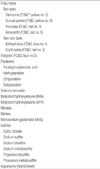Abstract
Many different additives include preservatives, stabilizers, conditioners, thickeners, colorings, flavorings, sweeteners, and antioxidants. Despite the multitude of additives known, only a small number has been associated with hypersensitivity reactions. A number of investigators have suggested that a significant population of patients with allergic diseases has symptoms related to the ingestion of food additives. However, the incidence and mechanism of reactions to additives in patients with chronic urticaria, angioedema, and atopic dermatitis remain unknown. A few studies of monosodium glutamate is reported to be associated with atopic dermatitis, but their relationship remains unknown. The best known dye is tartrazine. The group of azo dyes includes ponceau and sunset yellow. Amaranth (FD&C red no. 5) was banned from use in the US in 1975 because of claims related to carcinogenicity. Most of them are reported to be associated with aggravation of atopic dermatitis. Parabens are aliphatic esters of parahydroxybenzoic acid. Sodium benzoate is a closely related substance usually reported to cross-react with these compounds. These agents, which are widely used as preservatives in both food and drugs, are well recognized as causes of severe contact dermatitis. Additives would have to act as haptens to create a response mediated by IgE. The majority of these reactions are not of the immediate hypersensitivity type. Many cases of additive-provoked urticaria or dermatitis occur as late as 24 hours after challenge, arguing against an IgE-mediated mechanism. In conclusion, the exact relationship between food additives and the allergic diseases still remains to be solved.
Figures and Tables
Table 2
Food Additives which are Known to Provoke Adverse Reaction or Hypersensitivity

*Federal Food, Drug, and Cosmetic Act (FD&C Act) from US FDA; FD&D, Food, Drug, and Dye; FD&C, Food, Drug, and Cosmetic.
Ref. 37 with permission from Wiley-Blackwell.
References
1. Report No.: WHO food additives series no. 48. Safety evaluation of certain food additives and contaminants [Internet]. 2002. cited 2011 Sep 2. In : the fifty-seventh meeting of the Joint FAO/WHO Expert Committee on Food Additives; Geneva: World Health Organization;Available from: http://www.who.int/foodsafety/chem/jecfa/publications/monographs/en/index.html.
2. Joint FAO/WHO Codex Alimentarius Commission(CAC). Report No.: ALINORM 06/29/12. Distribution of the report of the thirty-eighth session of the Codex committee on food additives and contaminants [Internet]. 2006. cited 2011 Sep 3. Rome: Codex Alimentarius Commission;Available from: http://www.codexalimentarius.net/download/report/657/al29_12e.pdf.
3. Sporik R, Holgate ST, Platts-Mills TA, Cogswell JJ. Exposure to house-dust mite allergen (Der p I) and the development of asthma in childhood. A prospective study. N Engl J Med. 1990. 323:502–507.

4. Barnes RMR. Kay AB, editor. Principles and interpretation of laboratory tests for allergy. Allergy and allergic diseases. 1997. Hoboken: Blackwell;997–1005.
5. Boguniewicz M, Leung DYM. Adkinson NF, Middleton E, editors. Atopic dermatitis. Middleton's allergy: principles & practice. 2003. St. Louis: Mosby;1559–1580.

6. Leung DYM. Leung DYM, Sampson H, Geha R, editors. Atopic dermatitis. Pediatric allergy: principles and practice. 2003. St. Louis: Mosby;561–573.
8. Brostoff J, Challacombe SJ. Food allergy and intolerance. 2002. 2nd ed. Philadelphia: Saunders;454–455.
9. Oh JW, Pyun BY, Choung JT, Ahn KM, Kim CH, Song SW, et al. Epidemiological change of atopic dermatitis and food allergy in school-aged children in Korea between 1995 and 2000. J Korean Med Sci. 2004. 19:716–723.

10. Eggesbo M, Halvorsen R, Tambs K, Botten G. Prevalence of parentally perceived adverse reactions to food in young children. Pediatr Allergy Immunol. 1999. 10:122–132.

1. Sicherer SH, Muñoz-Furlong A, Murphy R, Wood RA, Sampson HA. Symposium: Pediatric Food Allergy. Pediatrics. 2003. 111:1591–1594.

12. Mofidi S. Nutritional management of pediatric food hypersensitivity. Pediatrics. 2003. 111:1645–1653.

13. Lee SY, Choi HM. Nutrition on infancy: food allergyed. 2003. Seoul: Kyomunsa;61–73.
14. Rhim JW, Moon KS, Kong DY, Pyun BY. An investigation into the actual condition of outbreak and treatment in atopic dermatitis. Pediatr Allergy Respir Dis. 2005. 15:44–52.
15. AW Burks, Sampson HA. Metcalfe DD, Sampson HA, Simon RA, editors. Anaphylaxis and food allergy. Food allergy: adverse reactions to foods and food additives. 1997. 2nd ed. Hoboken: Blackwell Science;246–247.
16. Gianocometi T. Filer LJ, editor. Free and bound glutamate in natural products. Glutamic acid: advances in biochemistry and physiology. 1979. New York: Raven Press;25–34.
17. Ghadimi H, Kumar S, Abaci F. Studies on monosodium glutamate ingestion: I. Biochemical explanation of Chinese restaurant syndrome. Biochemical Medicine. 1971. 5:447–456.
18. Botey J, Cozzo M, Marin A, Eseverri JL. Monosodium glutamate and skin pathology in pediatric allergology. Allergol Immunopathol (Madr). 1988. 16:425–428.
19. Speer F. The management of childhood asthmaed. 1958. Springfield: Charles C Thomas;23–40.
20. Lockey SD. Allergic reactions due to F D and C Yellow No. 5, tartrazine, an aniline dye used as a coloring and identifying agent in various steroids. Ann Allergy. 1959. 17:719–721.
23. Williams AE. Grayson M, Kirk RE, Mark HF, Othmer DFDF, Eckroth D, editors. Benzoic acid. Encyclopedia of chemical technology. 1978. New York: Wiley;778–792.
24. Lueck E. Antimicrobial food additives : characteristics, uses, effects. 1980. New York: Springer-Verlag;280.
26. Nettis E, Colanardi MC, Ferrannini A, Tursi A. Sodium benzoate-induced repeated episodes of acute urticaria/angio-oedema: randomized controlled trial. Br J Dermatol. 2004. 151:898–902.

27. Van Bever HP, Docx M, Stevens WJ. Food and food additives in severe atopic dermatitis. Allergy. 1989. 44:588–594.

28. Osterballe O, Taudorf E, Haahr J. Bronchial asthma caused by food preservatives, food coloring agents and aspirin in children. Ugeskr Laeger. 1979. 141:1908–1910.




 PDF
PDF ePub
ePub Citation
Citation Print
Print



 XML Download
XML Download